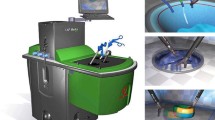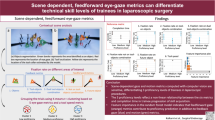Abstract
Purpose
Simulation-based training allows surgical skills to be learned safely. Most virtual reality-based surgical simulators address technical skills without considering non-technical skills, such as gaze use. In this study, we investigated surgeons’ visual behavior during virtual reality-based surgical training where visual guidance is provided. Our hypothesis was that the gaze distribution in the environment is correlated with the simulator’s technical skills assessment.
Methods
We recorded 25 surgical training sessions on an arthroscopic simulator. Trainees were equipped with a head-mounted eye-tracking device. A U-net was trained on two sessions to segment three simulator-specific areas of interest (AoI) and the background, to quantify gaze distribution. We tested whether the percentage of gazes in those areas was correlated with the simulator’s scores.
Results
The neural network was able to segment all AoI with a mean Intersection over Union superior to 94% for each area. The gaze percentage in the AoI differed among trainees. Despite several sources of data loss, we found significant correlations between gaze position and the simulator scores. For instance, trainees obtained better procedural scores when their gaze focused on the virtual assistance (Spearman correlation test, N = 7, r = 0.800, p = 0.031).
Conclusion
Our findings suggest that visual behavior should be quantified for assessing surgical expertise in simulation-based training environments, especially when visual guidance is provided. Ultimately visual behavior could be used to quantitatively assess surgeons’ learning curve and expertise while training on VR simulators, in a way that complements existing metrics.






Similar content being viewed by others
References
Badash I, Burtt K, Solorzano CA, Carey JN (2016) Innovations in surgery simulation: a review of past, current and future techniques. Ann Transl Med 4(23):453
De Visser H, Watson MO, Salvado O, Passenger JD (2011) Progress in virtual reality simulators for surgical training and certification. Med J Aust 194:S38–S40
Arjomandi Rad A, Vardanyan R, Thavarajasingam SG, Zubarevich A, Van den Eynde J, Sá MPB, Zhigalov K, Nia PM, Ruhparwar A, Weymann A (2022) Extended, virtual and augmented reality in thoracic surgery: a systematic review. Interact CardioVasc Thorac Surg 34(2):201–211
Canalichio KL, Berrondo C, Lendvay TS (2020) Simulation training in urology: state of the art and future directions. Adv Med Educ Pract 11:391
Hasan LK, Haratian A, Kim M, Bolia IK, Weber AE, Petrigliano FA (2021) Virtual reality in orthopedic surgery training. Adv Med Educ Pract 12:1295
Walbron P, Common H, Thomazeau H, Hosseini K, Peduzzi L, Bulaid Y, Sirveaux F (2020) Virtual reality simulator improves the acquisition of basic arthroscopy skills in first-year orthopedic surgery residents. Orthop Traumatol Surg Res 106(4):717–724
Satava RM (2008) Historical review of surgical simulation—a personal perspective. World J Surg 32(2):141–148
Brunckhorst O, Khan MS, Dasgupta P, Ahmed K (2015) Effective non-technical skills are imperative to robot-assisted surgery. BJU Int 116(6):842–844
Anderson O, Davis R, Hanna GB, Vincent CA (2013) Surgical adverse events: a systematic review. Am J Surg 206(2):253–262
Yule S, Flin R, Paterson-Brown S, Maran N, Rowley D (2006) Development of a rating system for surgeons’ non-technical skills. Med Educ 40(11):1098–1104
Sevdalis N, Davis R, Koutantji M, Undre S, Darzi A, Vincent CA (2008) Reliability of a revised NOTECHS scale for use in surgical teams. Am J Surg 196(2):184–190
Undre S, Sevdalis N, Healey AN, Darzi A, Vincent CA (2007) Observational teamwork assessment for surgery (OTAS): refinement and application in urological surgery. World J Surg 31(7):1373–1381
Casy T, Tronchot A, Thomazeau H, Morandi X, Jannin P, Huaulmé A (2022) “Stand-up straight!”: human pose estimation to evaluate postural skills during orthopedic surgery simulations. Int J Comput Assist Radiol Surg 18:279–288
Tolvanen O, Elomaa AP, Itkonen M, Vrzakova H, Bednarik R, Huotarinen A (2022) Eye-tracking indicators of workload in surgery: a systematic review. J Invest Surg 35(6):1340–1349
Gil AM, Birdi S, Kishibe T, Grantcharov TP (2022) Eye tracking use in surgical research: a systematic review. J Surg Res 279:774–787
Ashraf H, Sodergren MH, Merali N, Mylonas G, Singh H, Darzi A (2018) Eye-tracking technology in medical education: a systematic review. Med Teach 40(1):62–69
Wilson MR, Vine SJ, Bright E, Masters RS, Defriend D, McGrath JS (2011) Gaze training enhances laparoscopic technical skill acquisition and multi-tasking performance: a randomized, controlled study. Surg Endosc 25(12):3731–3739
Fox SE, Faulkner-Jones BE (2017) Eye-tracking in the study of visual expertise: methodology and approaches in medicine. Front Learn Res 5(3):29–40
Law B, Atkins MS, Lomax AJ, Wilson JG (2003) Eye trackers in a virtual laparoscopic training environment. In: Medicine meets virtual reality. IOS Press, vol 11, pp 184–186
Cai B, Xu N, Duan S, Yi J, Bay BH, Shen F, Hu N, Zhang P, Chen J, Chen C (2022) Eye tracking metrics of orthopedic surgeons with different competency levels who practice simulation-based hip arthroscopic procedures. Heliyon 8(12):12335
Dilley J, Singh H, Pratt P, Omar I, Darzi A, Mayer E (2020) Visual behaviour in robotic surgery—demonstrating the validity of the simulated environment. Int J Med Robot Comput Assist Surg 16(2):e2075
Evans-Harvey K, Erridge S, Karamchandani U, Abdalla S, Beatty JW, Darzi A, Purkayastha S, Sodergren MH (2020) Comparison of surgeon gaze behaviour against objective skill assessment in laparoscopic cholecystectomy-a prospective cohort study. Int J Surg 82:149–155
Snaineh STA, Seales B (2015) Minimally invasive surgery skills assessment using multiple synchronized sensors. In: 2015 IEEE international symposium on signal processing and information technology (ISSPIT), pp 314–319. IEEE
Burkhart SS, Lo IK (2006) Arthroscopic rotator cuff repair. JAAOS J Am Acad Orthop Surg 14(6):333–346
Kassner M, Patera W, Bulling A (2014) Pupil: an open source platform for pervasive eye tracking and mobile gaze-based interaction. In: Proceedings of the 2014 ACM international joint conference on pervasive and ubiquitous computing: adjunct publication. pp 1151–1160
Warfield SK, Zou KH, Wells WM (2004) Simultaneous truth and performance level estimation (STAPLE): an algorithm for the validation of image segmentation. IEEE Trans Med Imaging 23(7):903–921
He K, Zhang X, Ren S, Sun J (2016) Deep residual learning for image recognition. In: Proceedings of the IEEE conference on computer vision and pattern recognition, pp 770–778
Acknowledgements
This study is part of the French network of University Hospitals HUGO (“Hôpitaux Universitaires du Grand Ouest”). It was made possible thanks to the VirtaMed Society.
Author information
Authors and Affiliations
Corresponding author
Ethics declarations
Conflict of interest
The authors declare that they have no conflict of interest.
Ethical approval
All procedures involving human participants were conducted in accordance with the ethical standards of the institutional and/or national research committee and with the 1964 Helsinki declaration and its later amendments or comparable ethical standards.
Informed consent
This article does not contain patient data.
Additional information
Publisher's Note
Springer Nature remains neutral with regard to jurisdictional claims in published maps and institutional affiliations.
Rights and permissions
Springer Nature or its licensor (e.g. a society or other partner) holds exclusive rights to this article under a publishing agreement with the author(s) or other rightsholder(s); author self-archiving of the accepted manuscript version of this article is solely governed by the terms of such publishing agreement and applicable law.
About this article
Cite this article
Galuret, S., Vallée, N., Tronchot, A. et al. Gaze behavior is related to objective technical skills assessment during virtual reality simulator-based surgical training: a proof of concept. Int J CARS 18, 1697–1705 (2023). https://doi.org/10.1007/s11548-023-02961-8
Received:
Accepted:
Published:
Issue Date:
DOI: https://doi.org/10.1007/s11548-023-02961-8




